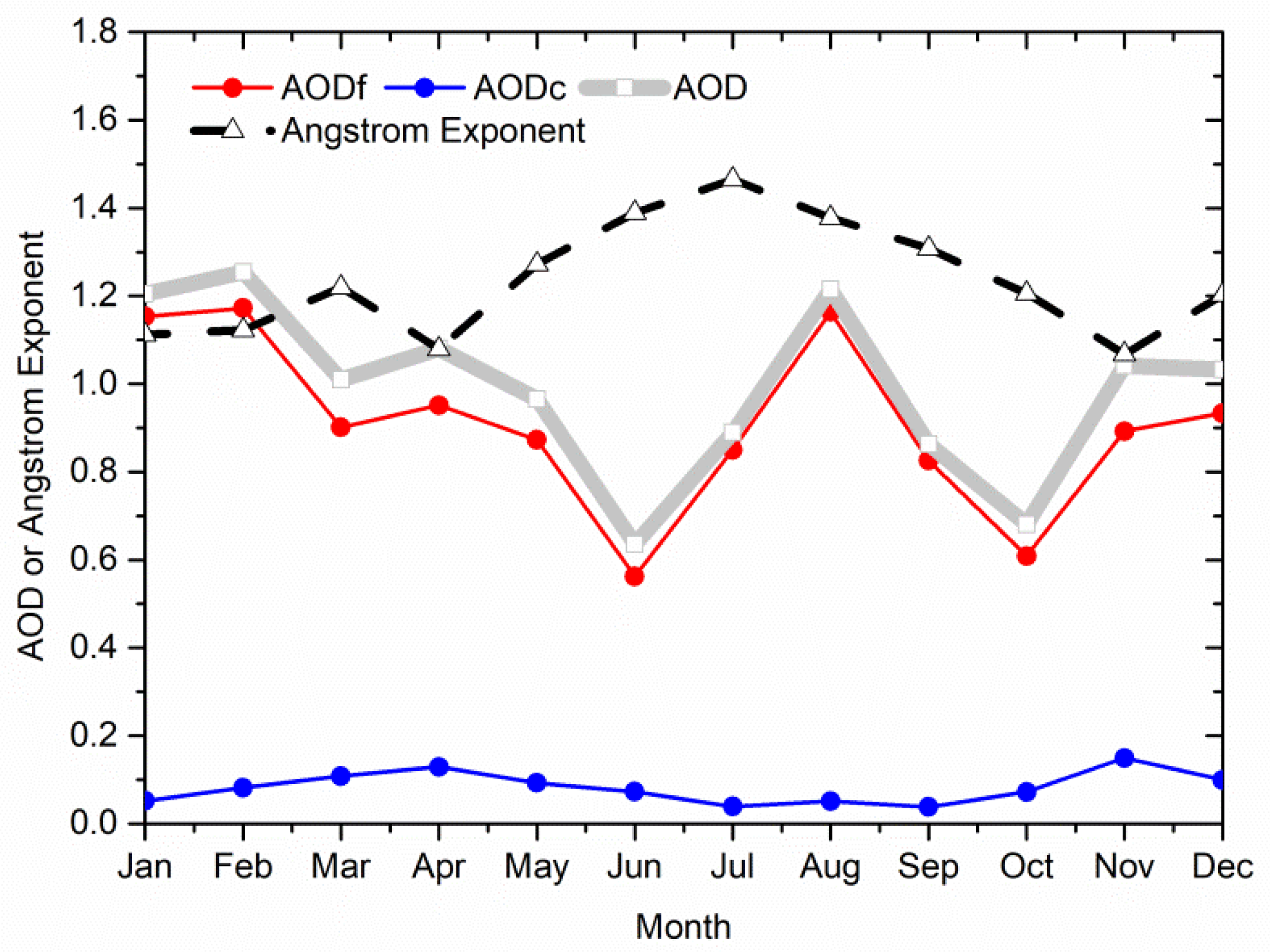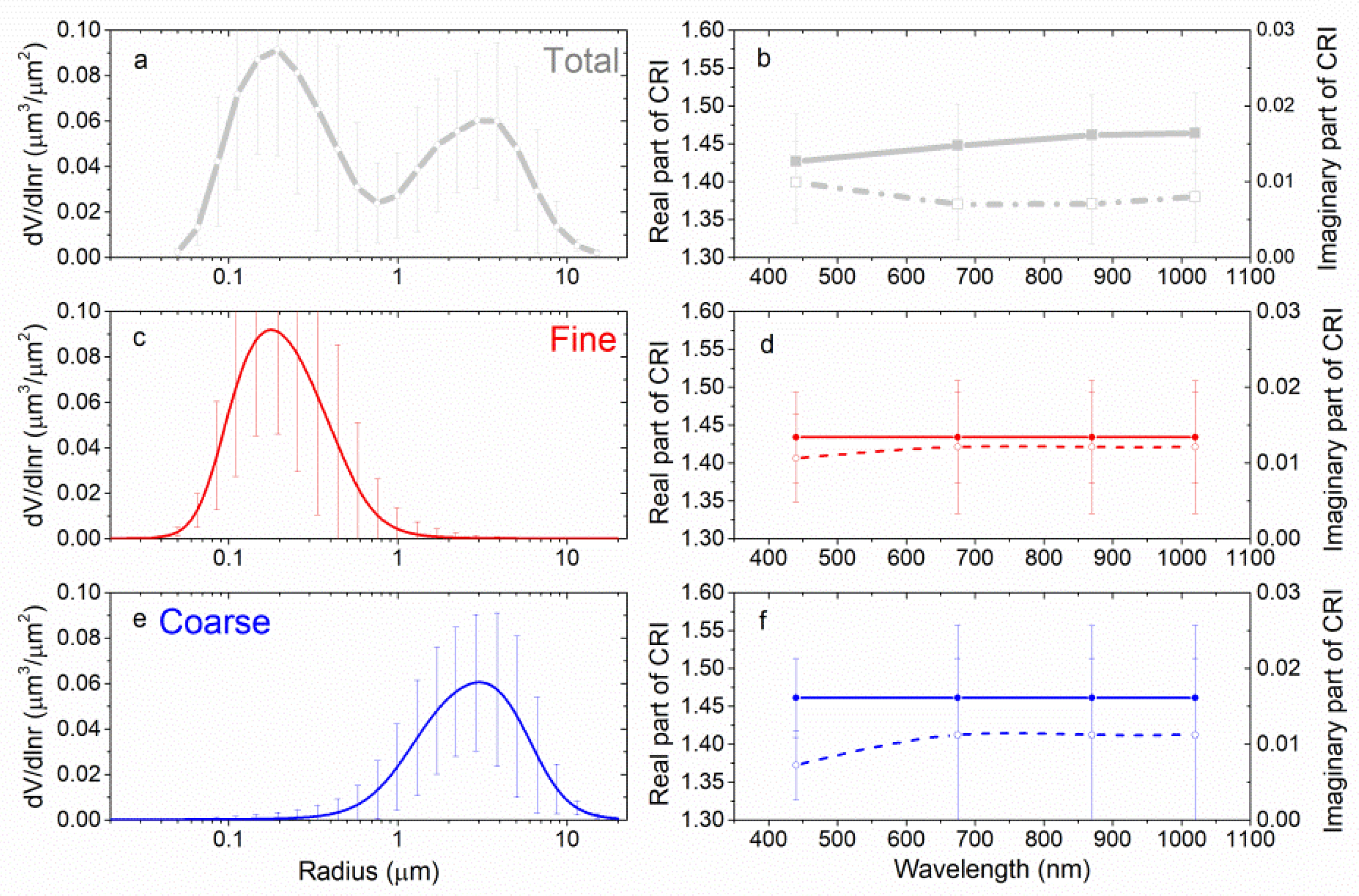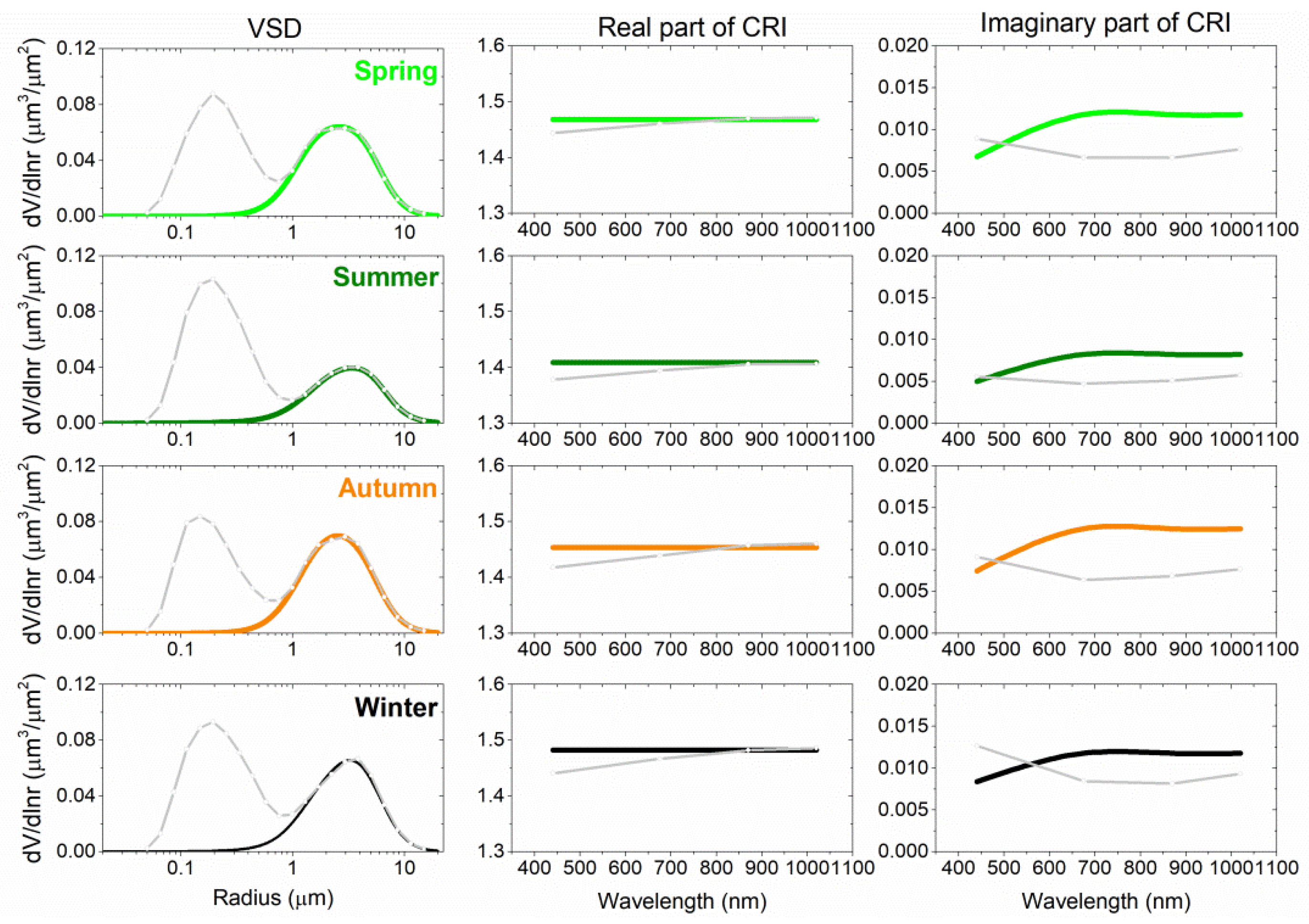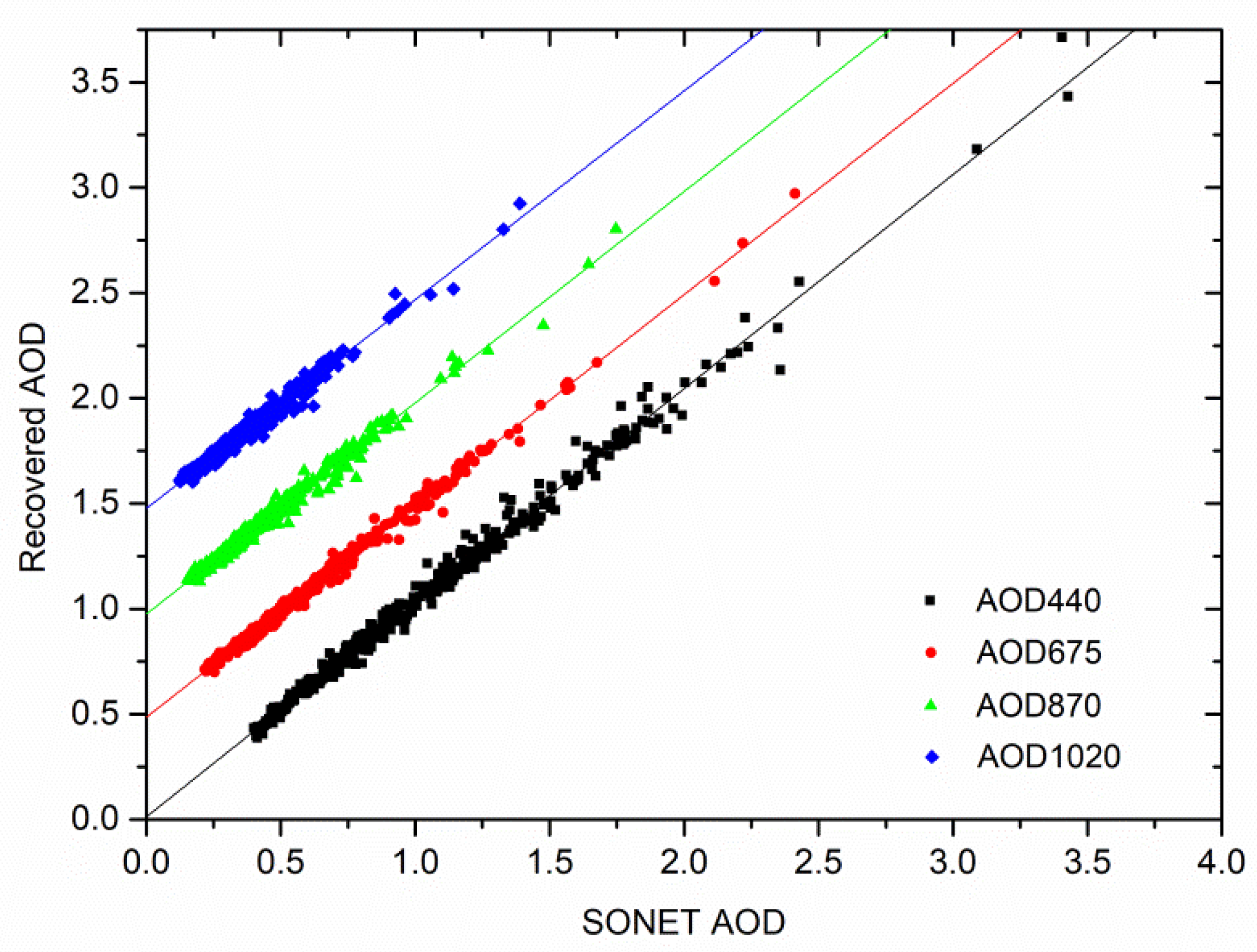Sub-Mode Aerosol Volume Size Distribution and Complex Refractive Index from the Three-Year Ground-Based Measurements in Chengdu China
Abstract
1. Introduction
2. Data and Method
2.1. Observation Site and Data
2.2. Method
3. Results
3.1. Fine- and Coarse-Mode AOD
3.2. Sub-Mode VSD
3.3. Fine- and Coarse-Mode VSD and CRI
4. Discussion
5. Conclusions
Author Contributions
Acknowledgments
Conflicts of Interest
References
- Twomey, S. Pollution and the planetary albedo. Atmos. Environ. (1967) 1974, 8, 1251–1256. [Google Scholar] [CrossRef]
- Kazil, J.; Stier, P.; Zhang, K.; Quaas, J.; Kinne, S.; O’donnell, D.; Rast, S.; Esch, M.; Ferrachat, S.; Lohmann, U. Aerosol nucleation and its role for clouds and Earth’s radiative forcing in the aerosol-climate model ECHAM5-HAM. Atmos. Chem. Phys. 2010, 10, 10733–10752. [Google Scholar] [CrossRef]
- Albrecht, B.A. Aerosols, cloud microphysics, and fractional cloudiness. Science 1989, 245, 1227–1231. [Google Scholar] [CrossRef] [PubMed]
- Pöschl, U. Atmospheric Aerosols: Composition, Transformation, Climate and Health Effects. Angew. Chem. Int. Ed. 2005, 44, 7520–7540. [Google Scholar] [CrossRef] [PubMed]
- Liao, W.; Wang, X.; Fan, Q.; Zhou, S.; Chang, M.; Wang, Z.; Wang, Y.; Tu, Q. Long-term atmospheric visibility, sunshine duration and precipitation trends in South China. Atmos. Environ. 2015, 107, 204–216. [Google Scholar] [CrossRef]
- Pan, L.; Che, H.; Geng, F.; Xia, X.; Wang, Y.; Zhu, C.; Chen, M.; Gao, W.; Guo, J. Aerosol optical properties based on ground measurements over the Chinese Yangtze Delta Region. Atmos. Environ. 2010, 44, 2587–2596. [Google Scholar] [CrossRef]
- Tao, J.; Cheng, T.; Zhang, R.; Cao, J.; Zhu, L.; Wang, Q.; Luo, L.; Zhang, L. Chemical composition of PM2.5 at an urban site of Chengdu in southwestern China. Adv. Atmos. Sci. 2013, 30, 1070–1084. [Google Scholar] [CrossRef]
- Tao, M.; Chen, L.; Wang, Z.; Tao, J.; Che, H.; Wang, X.; Wang, Y. Comparison and evaluation of the MODIS Collection 6 aerosol data in China. J. Geophys. Res. Atmos. 2015, 120, 6992–7005. [Google Scholar] [CrossRef]
- Deng, L.; Qian, J.; Liao, R.; Tong, H. Pollution characteristics of atmospheric particulates in Chengdu from August to September in 2009 and their relationship with meteorological conditions. China Environ. Sci. 2012, 32, 1433–1438. [Google Scholar]
- Li, X.; Yang, Z.; Fu, P.; Yu, J.; Lang, Y.-c.; Liu, D.; Ono, K.; Kawamura, K. High abundances of dicarboxylic acids, oxocarboxylic acids, and α-dicarbonyls in fine aerosols (PM2.5) in Chengdu, China during wintertime haze pollution. Environ. Sci. Pollut. Res. 2015, 22, 12902–12918. [Google Scholar] [CrossRef]
- Yong, L.; Allen, P.A.; Densmore, A.L.; Qiang, X. Evolution of the Longmen Shan foreland basin (western Sichuan, China) during the Late Triassic Indosinian orogeny. Basin Res. 2003, 15, 117–138. [Google Scholar] [CrossRef]
- Wang, Q.; Cao, J.; Shen, Z.; Tao, J.; Xiao, S.; Luo, L.; He, Q.; Tang, X. Chemical characteristics of PM2.5 during dust storms and air pollution events in Chengdu, China. Particuology 2012, 11, 70–77. [Google Scholar] [CrossRef]
- Hsu, N.C.; Tsay, S.-C.; King, M.D.; Herman, J.R. Deep Blue Retrievals of Asian Aerosol Properties during ACE-Asia. IEEE Trans. Geosci. Remote Sens. 2006, 44, 3180–3195. [Google Scholar] [CrossRef]
- Remer, L.; Kaufman, Y.; Tanré, D.; Mattoo, S.; Chu, D.; Martins, J.; Li, R.; Ichoku, C.; Levy, R.; Kleidman, R. The MODIS Aerosol Algorithm, Products and Validation. J. Atmos. Sci. 2005, 62, 947–973. [Google Scholar] [CrossRef]
- Remer, L.; Mattoo, S.; Levy, R.; Munchak, L. MODIS 3 km aerosol product: Algorithm and global perspective. Atmos. Meas. Tech. 2013, 6, 1829–1844. [Google Scholar] [CrossRef]
- Liu, X.; Chen, Q.; Che, H.; Zhang, R.; Gui, K.; Zhang, H.; Zhao, T. Spatial distribution and temporal variation of aerosol optical depth in the Sichuan basin, China, the recent ten years. Atmos. Environ. 2016, 147, 434–445. [Google Scholar] [CrossRef]
- Shi, G.; Liu, R.; Wang, D.Y.; Yang, F. Evaluation of the MODIS C6 Aerosol Optical Depth Products over Chongqing, China. Atmosphere 2017, 8, 227. [Google Scholar] [CrossRef]
- Lin, M.; Tao, J.; Chan, C.-Y.; Cao, J.-J.; Zhang, Z.-S.; Zhu, L.-H.; Zhang, R.-J. Characterization of Regression Relationship between Recent Air Quality and Visibility Changes in Megacities at Four Haze Regions of China. Aerosol Air Qual. Res. 2012, 12, 1049–1061. [Google Scholar] [CrossRef]
- Tao, J.; Zhang, L.; Cao, J.; Hsu, S.-C.; Xia, X.; Zhang, Z.; Lin, Z.; Cheng, T.; Zhang, R. Characterization and source apportionment of aerosol light extinction in Chengdu, southwest China. Atmos. Environ. 2014, 95, 552–562. [Google Scholar] [CrossRef]
- Tao, R.; Che, H.; Chen, Q.; Tao, J.; Wang, Y.; Sun, J.; Wang, H.; Zhang, X. Study of Aerosol Optical Properties Based on Ground Measurements over Sichuan Basin, China. Aerosol Air Qual. Res. 2014, 14, 905–915. [Google Scholar] [CrossRef]
- Dubovik, O.; King, M.D. A flexible inversion algorithm for retrieval of aerosol optical properties from Sun and sky radiance measurements. J. Geophys. Res. 2000, 105, 20673–20696. [Google Scholar] [CrossRef]
- Eck, T.F.; Holben, B.N.; Reid, J.; Giles, D.; Rivas, M.; Singh, R.P.; Tripathi, S.; Bruegge, C.; Platnick, S.; Arnold, G. Fog-and cloud-induced aerosol modification observed by the Aerosol Robotic Network (AERONET). J. Geophys. Res. Atmos. 2012, 117, 107–116. [Google Scholar] [CrossRef]
- Li, Z.; Eck, T.; Zhang, Y.; Zhang, Y.; Li, D.; Li, L.; Xu, H.; Hou, W.; Lv, Y.; Goloub, P. Observations of residual submicron fine aerosol particles related to cloud and fog processing during a major pollution event in Beijing. Atmos. Environ. 2014, 86, 187–192. [Google Scholar] [CrossRef]
- Dubovik, O.; Smirnov, A.; Holben, B.; King, M.; Kaufman, Y.; Eck, T.; Slutsker, I. Accuracy assessments of aerosol optical properties retrieved from Aerosol Robotic Network (AERONET) Sun and sky radiance measurements. J. Geophys. Res. Atmos. 2000, 105, 9791–9806. [Google Scholar] [CrossRef]
- O’Neill, N.; Eck, T.; Holben, B.; Smirnov, A.; Dubovik, O.; Royer, A. Bimodal size distribution influences on the variation of Angstrom derivatives in spectral and optical depth space. J. Geophys. Res. 2001, 106, 9787–9806. [Google Scholar] [CrossRef]
- Dubovik, O.; Sinyuk, A.; Lapyonok, T.; Holben, B.N.; Mishchenko, M.; Yang, P.; Eck, T.F.; Volten, H.; Muñoz, O.; Veihelmann, B. Application of spheroid models to account for aerosol particle nonsphericity in remote sensing of desert dust. J. Geophys. Res. Atmos. 2006, 111. [Google Scholar] [CrossRef]
- Holben, B.N.; Eck, T.; Slutsker, I.; Tanre, D.; Buis, J.; Setzer, A.; Vermote, E.; Reagan, J.; Kaufman, Y.; Nakajima, T. AERONET—A federated instrument network and data archive for aerosol characterization. Remote Sens. Environ. 1998, 66, 1–16. [Google Scholar] [CrossRef]
- Li, Z.; Xu, H.; Li, K.; Li, D.; Xie, Y.; Li, L.; Zhang, Y.; Gu, X.; Zhao, W.; Tian, Q. Comprehensive Study of Optical, Physical, Chemical, and Radiative Properties of Total Columnar Atmospheric Aerosols over China: An Overview of Sun–Sky Radiometer Observation Network (SONET) Measurements. Bull. Am. Meteorol. Soc. 2018, 99, 739–755. [Google Scholar] [CrossRef]
- Li, Z.; Blarel, L.; Podvin, T.; Goloub, P.; Buis, J.P.; Morel, J.P. Transferring the calibration of direct solar irradiance to diffuse-sky radiance measurements for CIMEL Sun-sky radiometers. Appl. Opt. 2008, 47, 1368–1377. [Google Scholar] [CrossRef]
- Holben, B.N.; Kim, J.; Sano, I.; Mukai, S.; Eck, T.F.; Giles, D.M.; Schafer, J.S.; Sinyuk, A.; Slutsker, I.; Smirnov, A. An overview of mesoscale aerosol processes, comparisons, and validation studies from DRAGON networks. Atmos. Chem. Phys. 2018, 18, 1–23. [Google Scholar] [CrossRef]
- Smirnov, A.; Holben, B.; Eck, T.; Dubovik, O.; Slutsker, I. Cloud-screening and quality control algorithms for the AERONET database. Remote Sens. Environ. 2000, 73, 337–349. [Google Scholar] [CrossRef]
- Zhang, Y.; Li, Z.; Zhang, Y.; Chen, Y.; Cuesta, J.; Ma, Y. Multi-peak accumulation and coarse modes observed from AERONET retrieved aerosol volume size distribution in Beijing. Meteorol. Atmos. Phys. 2016, 128, 537–544. [Google Scholar] [CrossRef]
- Cuesta, J.; Flamant, P.H.; Flamant, C. Synergetic technique combining elastic backscatter lidar data and sunphotometer AERONET inversion for retrieval by layer of aerosol optical and microphysical properties. Appl. Opt. 2008, 47, 4598–4611. [Google Scholar] [CrossRef] [PubMed]
- Zhang, Y.; Li, Z.; Zhang, Y.; Li, D.; Qie, L.; Che, H.; Xu, H. Estimation of aerosol complex refractive indices for both fine and coarse modes simultaneously based on AERONET remote sensing products. Atmos. Meas. Tech. 2017, 10, 1–17. [Google Scholar] [CrossRef]
- Heller, W. Remarks on Refractive Index Mixture Rules. J. Phys. Chem. 1965, 69, 1123–1129. [Google Scholar] [CrossRef]
- O’Neill, N.; Eck, T.; Smirnov, A.; Holben, B.; Thulasiraman, S. Spectral discrimination of coarse and fine mode optical depth. J. Geophys. Res. Atmos. 2003, 108. [Google Scholar] [CrossRef]
- Chen, Y.; Xie, S.-D. Characteristics and formation mechanism of a heavy air pollution episode caused by biomass burning in Chengdu, Southwest China. Sci. Total Environ. 2014, 473, 507–517. [Google Scholar] [CrossRef] [PubMed]
- Liu, Y.M.; Wu, G.X.; Liu, H.; Liu, P. Condensation heating of the Asian summer monsoon and the subtropical anticyclone in the Eastern Hemisphere. Clim. Dyn. 2001, 17, 327–338. [Google Scholar] [CrossRef]
- Kroll, J.H.; Seinfeld, J.H. Chemistry of secondary organic aerosol: Formation and evolution of low-volatility organics in the atmosphere. Atmos. Environ. 2008, 42, 3593–3624. [Google Scholar] [CrossRef]
- Gobbi, G.P.; Kaufman, Y.J.; Koren, I.; Eck, T.F. Classification of aerosol properties derived from AERONET direct sun data. Atmos. Chem. Phys. 2007, 7, 8713–8726. [Google Scholar] [CrossRef]
- Kaufman, Y.J. Aerosol optical thickness and atmospheric path radiance. J. Geophys. Res. Atmos. 1993, 98, 2677–2692. [Google Scholar] [CrossRef]
- King, M.D.; Byrne, D.M.; Herman, B.M.; Reagan, J.A. Aerosol Size Distributions Obtained by Inversion of Spectral Optical Depth Measurements. J. Atmos. Sci. 1978, 35, 2153–2167. [Google Scholar] [CrossRef]
- Gong, S.L.; Zhang, X.Y.; Zhao, T.L.; Mckendry, I.G.; Jaffe, D.A.; Lu, N.M. Characterization of soil dust aerosol in China and its transport and distribution during 2001 ACE-Asia: 2. Model simulation and validation. J. Geophys. Res. 2003, 108. [Google Scholar] [CrossRef]
- Wang, Y.; Sun, Y.; Xin, J.; Li, Z.; Wang, S.; Wang, P.; Hao, W.M.; Nordgren, B.L.; Chen, H.; Wang, L. Seasonal variations in aerosol optical properties over China. Atmos. Chem. Phys. Discuss. 2008, 8, 8431–8453. [Google Scholar] [CrossRef]
- Che, H.; Xia, X.; Zhu, J.; Li, Z.; Dubovik, O.; Holben, B.; Goloub, P.; Chen, H.; Estelles, V.; Cuevas-Agulló, E. Column aerosol optical properties and aerosol radiative forcing during a serious haze-fog month over North China Plain in 2013 based on ground-based sunphotometer measurements. Atmos. Chem. Phys. 2014, 14, 2125–2138. [Google Scholar] [CrossRef]
- Willeke, K.; Whitby, K. Atmospheric Aerosols: Size Distribution Interpretation. J. Air Pollut. Control Assoc. 1975, 25, 529–534. [Google Scholar] [CrossRef]
- Kulmala, M.; Vehkamäki, H.; Petäjä, T.; Maso, M.D.; Lauri, A.; Kerminen, V.M.; Birmili, W.; Mcmurry, P.H. Formation and growth rates of ultrafine atmospheric particles: A review of observations. J. Aerosol Sci. 2004, 35, 143–176. [Google Scholar] [CrossRef]
- Liu, X.; Li, J.; Qu, Y.; Han, T.; Hou, L.; Gu, J.; Chen, C.; Yang, Y.; Liu, X.; Yang, T. Formation and evolution mechanism of regional haze: A case study in the megacity Beijing, China. Atmos. Chem. Phys. 2013, 13, 4501–4514. [Google Scholar] [CrossRef]
- Hammer, E.; Gysel, M.; Roberts, G.C.; Elias, T.; Hofer, J.; Hoyle, C.R.; Bukowiecki, N.; Dupont, J.C.; Burnet, F.; Baltensperger, U. Size-dependent particle activation properties in fog during the ParisFog 2012/13 field campaign. Atmos. Chem. Phys. 2014, 14, 9475–9516. [Google Scholar] [CrossRef]
- Su, X.; Cao, J.; Li, Z.; Li, K.; Xu, H.; Liu, S.; Fan, X. Multi-Year Analyses of Columnar Aerosol Optical and Microphysical Properties in Xi’an, a Megacity in Northwestern China. Remote Sens. 2018, 10, 1169. [Google Scholar] [CrossRef]
- Dubovik, O.; Holben, B.; Eck, T.F.; Smirnov, A.; Kaufman, Y.J.; King, M.D.; Tanré, D.; Slutsker, I. Variability of Absorption and Optical Properties of Key Aerosol Types Observed in Worldwide Locations. J. Atmos. Sci. 2002, 59, 590–608. [Google Scholar] [CrossRef]
- Li, Z.; Gu, X.; Wang, L.; Li, D. Aerosol physical and chemical properties retrieved from ground-based remote sensing measurements during heavy haze days in Beijing winter. Atmos. Chem. Phys. 2013, 13, 10171–10183. [Google Scholar] [CrossRef]
- Wang, L.; Li, Z.-Q.; Li, D.-H.; Li, K.-T.; Tian, Q.J.; Li, L.; Zhang, Y.; Lv, Y. Retrieval of Dust Fraction of Atmospheric Aerosols Based on Spectra Characteristics of Refractive Indices Obtained from Remote Sensing Measurements. Spectrosc. Spectral Anal. 2012, 32, 1644. [Google Scholar]
- Schuster, G.L.; Dubovik, O.; Holben, B.N.; Clothiaux, E.E. Inferring black carbon content and specific absorption from Aerosol Robotic Network (AERONET) aerosol retrievals. J. Geophys. Res. Atmos. 2005, 110. [Google Scholar] [CrossRef]
- Bodhaine, B.A. Aerosol absorption measurements at Barrow, Mauna Loa, and the South Pole. J. Geophys. Res. Atmos. 1995, 100, 8967–8975. [Google Scholar] [CrossRef]
- Lee, K.H.; Li, Z.; Man, S.W.; Xin, J.; Wang, Y.; Hao, W.M.; Zhao, F. Aerosol single scattering albedo estimated across China from a combination of ground and satellite measurements. J. Geophys. Res. Atmos. 2007, 112. [Google Scholar] [CrossRef]
- Surabi, M.; James, H.; Larissa, N.; Yunfeng, L. Climate effects of black carbon aerosols in China and India. Science 2002, 297, 2250–2253. [Google Scholar]
- Hansen, J.E.; Sato, M.; Ruedy, R. Radiative forcing and climate response. J. Geophys. Res. Atmos. 1997, 102, 6831–6864. [Google Scholar] [CrossRef]








| R (μm) | V (μm3/μm2) | ||
|---|---|---|---|
| Fine | 0.17 ± 0.05 | 1.55 ± 0.18 | 0.10 ± 0.07 |
| SMF | 0.31 ± 0.12 | 1.69 ± 0.28 | 0.09 ± 0.05 |
| SMC | 1.62 ± 0.45 | 1.83 ± 0.35 | 0.07 ± 0.05 |
| Coarse | 3.25 ± 0.99 | 1.82 ± 0.29 | 0.09 ± 0.05 |
| Aerosol Properties | Mode | Parameter | Multi-Year Average | Spring | Summer | Autumn | Winter |
|---|---|---|---|---|---|---|---|
| Real Part of Refractive Index | Fine | λ(440–1020 nm) | 1.43 ± 0.06 | 1.45 ± 0.05 | 1.38 ± 0.04 | 1.43 ± 0.06 | 1.45 ± 0.06 |
| Coarse | λ(440–1020 nm) | 1.46 ± 0.05 | 1.47 ± 0.05 | 1.41 ± 0.03 | 1.45 ± 0.04 | 1.48 ± 0.05 | |
| Total | λ(440 nm) | 1.43 ± 0.06 | 1.44 ± 0.05 | 1.38 ± 0.04 | 1.42 ± 0.06 | 1.44 ± 0.06 | |
| λ(675 nm) | 1.45 ± 0.05 | 1.46 ± 0.05 | 1.39 ± 0.03 | 1.44 ± 0.05 | 1.47 ± 0.05 | ||
| λ(870 nm) | 1.46 ± 0.05 | 1.47 ± 0.05 | 1.41 ± 0.03 | 1.46 ± 0.04 | 1.48 ± 0.05 | ||
| λ(1020 nm) | 1.46 ± 0.05 | 1.47 ± 0.05 | 1.41 ± 0.03 | 1.46 ± 0.04 | 1.49 ± 0.05 | ||
| Imaginary Part of Refractive Index | Fine | λ(440 nm) | 0.011 ± 0.006 | 0.010 ± 0.006 | 0.006 ± 0.004 | 0.010 ± 0.005 | 0.014 ± 0.005 |
| λ(675–1020 nm) | 0.012 ± 0.009 | 0.011 ± 0.014 | 0.008 ± 0.005 | 0.011 ± 0.006 | 0.015 ± 0.006 | ||
| Coarse | λ(440 nm) | 0.007 ± 0.005 | 0.007 ± 0.007 | 0.005 ± 0.003 | 0.007 ± 0.004 | 0.008 ± 0.003 | |
| λ(675–1020 nm) | 0.011 ± 0.014 | 0.012 ± 0.002 | 0.008 ± 0.006 | 0.013 ± 0.022 | 0.012 ± 0.007 | ||
| Total | λ(440 nm) | 0.010 ± 0.006 | 0.009 ± 0.006 | 0.006 ± 0.003 | 0.009 ± 0.004 | 0.013 ± 0.005 | |
| λ(675 nm) | 0.007 ± 0.005 | 0.007 ± 0.007 | 0.005 ± 0.003 | 0.006 ± 0.004 | 0.008 ± 0.003 | ||
| λ(870 nm) | 0.007 ± 0.005 | 0.007 ± 0.009 | 0.005 ± 0.003 | 0.007 ± 0.004 | 0.008 ± 0.003 | ||
| λ(1020 nm) | 0.008 ± 0.006 | 0.008 ± 0.010 | 0.006 ± 0.004 | 0.008 ± 0.004 | 0.009 ± 0.004 | ||
| Volume Particle Size Distribution | Fine | 0.20 ± 0.05 | 0.20 ± 0.04 | 0.21 ± 0.05 | 0.18 ± 0.03 | 0.21 ± 0.05 | |
| 0.55 ± 0.07 | 0.53 ± 0.06 | 0.54 ± 0.07 | 0.55 ± 0.06 | 0.56 ± 0.08 | |||
| 0.15 ± 0.08 | 0.13 ± 0.06 | 0.17 ± 0.09 | 0.13 ± 0.07 | 0.16 ± 0.09 | |||
| Coarse | 2.86 ± 0.52 | 2.56 ± 0.43 | 3.08 ± 0.50 | 2.57 ± 0.41 | 3.05 ± 0.47 | ||
| 0.62 ± 0.06 | 0.64 ± 0.06 | 0.60 ± 0.06 | 0.63 ± 0.05 | 0.61 ± 0.07 | |||
| 0.11 ± 0.06 | 0.12 ± 0.06 | 0.07 ± 0.05 | 0.12 ± 0.06 | 0.11 ± 0.05 |
© 2019 by the authors. Licensee MDPI, Basel, Switzerland. This article is an open access article distributed under the terms and conditions of the Creative Commons Attribution (CC BY) license (http://creativecommons.org/licenses/by/4.0/).
Share and Cite
Zhang, C.; Zhang, Y.; Li, Z.; Wang, Y.; Xu, H.; Li, K.; Li, D.; Xie, Y.; Zhang, Y. Sub-Mode Aerosol Volume Size Distribution and Complex Refractive Index from the Three-Year Ground-Based Measurements in Chengdu China. Atmosphere 2019, 10, 46. https://doi.org/10.3390/atmos10020046
Zhang C, Zhang Y, Li Z, Wang Y, Xu H, Li K, Li D, Xie Y, Zhang Y. Sub-Mode Aerosol Volume Size Distribution and Complex Refractive Index from the Three-Year Ground-Based Measurements in Chengdu China. Atmosphere. 2019; 10(2):46. https://doi.org/10.3390/atmos10020046
Chicago/Turabian StyleZhang, Chi, Ying Zhang, Zhengqiang Li, Yongqian Wang, Hua Xu, Kaitao Li, Donghui Li, Yisong Xie, and Yang Zhang. 2019. "Sub-Mode Aerosol Volume Size Distribution and Complex Refractive Index from the Three-Year Ground-Based Measurements in Chengdu China" Atmosphere 10, no. 2: 46. https://doi.org/10.3390/atmos10020046
APA StyleZhang, C., Zhang, Y., Li, Z., Wang, Y., Xu, H., Li, K., Li, D., Xie, Y., & Zhang, Y. (2019). Sub-Mode Aerosol Volume Size Distribution and Complex Refractive Index from the Three-Year Ground-Based Measurements in Chengdu China. Atmosphere, 10(2), 46. https://doi.org/10.3390/atmos10020046








